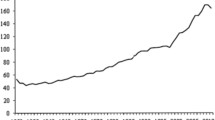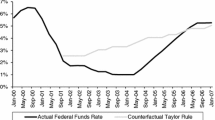Abstract
The financial crisis of 2008 led to questions of whether monetary policy alone was sufficient to stabilise the macroeconomy and the financial system. The result has been an emphasis on macroprudential financial regulation to act in tandem with monetary policy. This article describes the emergence of macroprudential policy, how historical financial crises might have been mitigated had it been in place, and its ambidexterity with monetary policy as twin instruments for macroeconomic stabilisation.












Similar content being viewed by others
References
Aikman, D., A.G. Haldane and B.D. Nelson 2014. “Curbing the Credit Cycle.” The Economic Journal, forthcoming, doi: 10.1111/ecoj.12113/.
Bank of England, 2009. The Role of Macroprudential Policy. Discussion Paper: http://www.bankofengland.co.uk/publications/Documents/other/financialstability/roleofmacroprudentialpolicy091121.pdf (accessed March 6, 2014).
Bank of England, 2011. Instruments of Macroprudential Policy. Discussion paper: http://www.bankofengland.co.uk/publications/ Documents/events/ccbs_workshop2012/paper_kapadia.pdf (accessed March 6, 2014).
Basel Committee on Bank Supervision, 2010. Basel III: A Global Regulatory Framework for More Resilient Banks and Banking Systems, Bank for International Settlements. http://www.bis.org/publ/bcbs189.pdf (accessed March 6, 2014).
Bordo, M., B. Eichengreen, D. Klingebiel, M.S. Martinez-Peria and A.K. Rose 2001. “Is the crisis problem growing more severe?” Economic Policy, 16 (32): 53–82.
Chari, V.V. and P. Kehoe 2013. Bailouts, Time Inconsistency and Optimal Regulation. NBER Working Paper no. 19192.
De Paoli, B. and M. Paustian 2013. Coordinating Monetary and Macroprudential policies. Staff Reports 653, Federal Reserve Bank of New York.
Goodfriend, M. 2007. “How the World Achieved Consensus on Monetary Policy.” Journal of Economic Perspectives, 21 (4): 47–68.
Haldane, A.G. 2013. Why Institutions Matter (More Than Ever). http://www.bankofengland.co.uk/publications/Documents/speeches/2013/speech676.pdf (accessed March 6, 2014).
Hanson, Samuel G., Anil K. Kashyap and Jeremy C. Stein 2011. “A Macroprudential Approach to Financial Regulation.” Journal of Economic Perspectives, 25 (1): 3–28.
International Monetary Fund, 2013. Key Aspects of Macroprudential Policy. http://www.imf.org/external/np/pp/eng/2013/061013b.pdf (accessed March 6, 2014).
King, M.A. 2013. A Governor Looks Back—and Forward. http://www.bankofengland.co.uk/publications/Documents/speeches/2013/speech670.pdf (accessed March 6, 2014).
Kydland, F.E. and E.C. Prescott 1977. “Rules rather than Discretion: The Inconsistency of Optimal Plans.” Journal of Political Economy, 85 (3): 473–492.
Morris, S. and H-S Shin 2008. “Financial Regulation in a System Context.” Brookings Papers on Economic Activity, 39 (2): 229–274.
Minsky, H. 1986. Stabilising an Unstable Economy. Yale University Press.
Reinhart, C. and K. Rogoff 2008. This Time is Different: A Panoramic View of Eight Centuries of Financial Crises. NBER Working Paper 13882.
Stein, J.C. 2013. “Overheating in Credit Markets: Origins, Measurement, and Policy Responses” http://www.federalreserve.gov/newsevents/speech/stein20130207a.htm (accessed March 6, 2014).
Taylor, J. 1993. “Discretion versus Policy Rules in Practice.” Carnegie-Rochester Conference Series on Public Policy, 39 (1): 195–214.
Tinbergen, J. 1952. On the Theory of Economic Policy, 2nd ed. North-Holland.
Additional information
Based on a presentation at the NABE session of the Allied Social Sciences Associations’ Annual Meeting, January 4, 2014.
*Andrew G. Haldane is Executive Director for Financial Stability of the Bank of England. He has responsibility for developing Bank policy on financial stability issues and the management of the Financial Stability Area. He is a member of the Financial Policy Committee as well as several senior management committees of the Bank. He is also a member of the Basel Committee. Haldane joined the Bank in 1989. In previous roles he headed the Bank's work on risk assessment, market infrastructure, and international finance. Prior to that, he worked on monetary policy strategy, inflation targeting, and central bank independence. Haldane has written extensively on domestic and international monetary and financial stability. He is the co-founder of a charity “Pro Bono Economics,” which aims to broker economists into projects in the charitable sector.
Rights and permissions
About this article
Cite this article
Haldane, A. Central Banks and Macroeconomic Ambidexterity. Bus Econ 49, 92–98 (2014). https://doi.org/10.1057/be.2014.10
Published:
Issue Date:
DOI: https://doi.org/10.1057/be.2014.10




